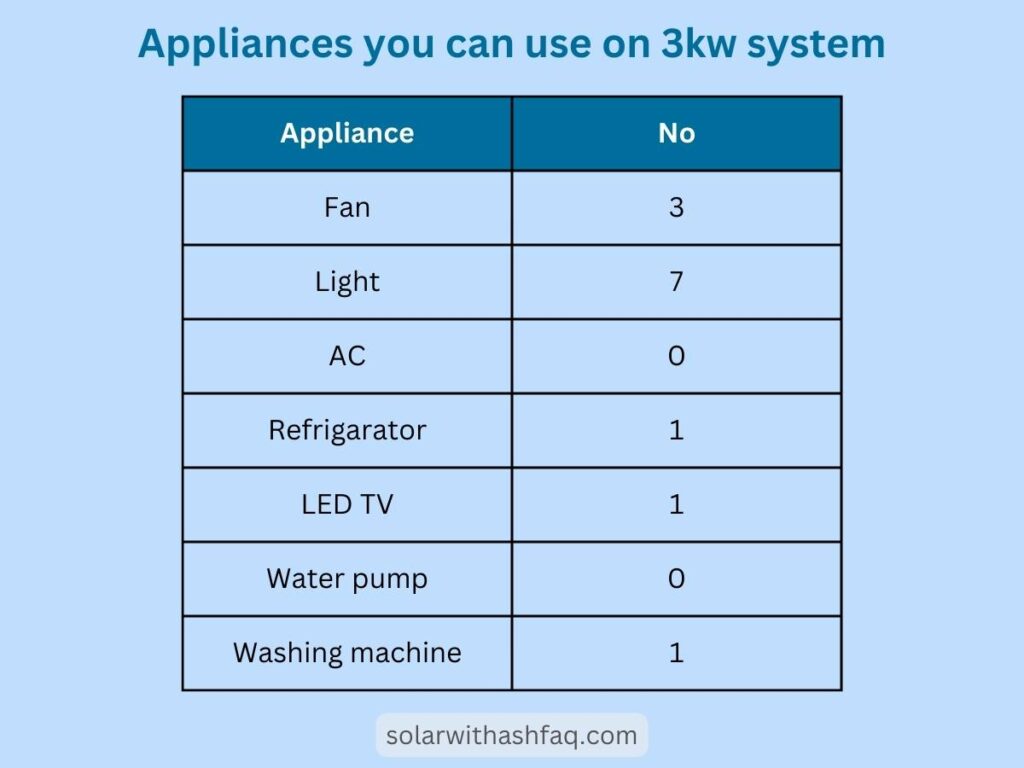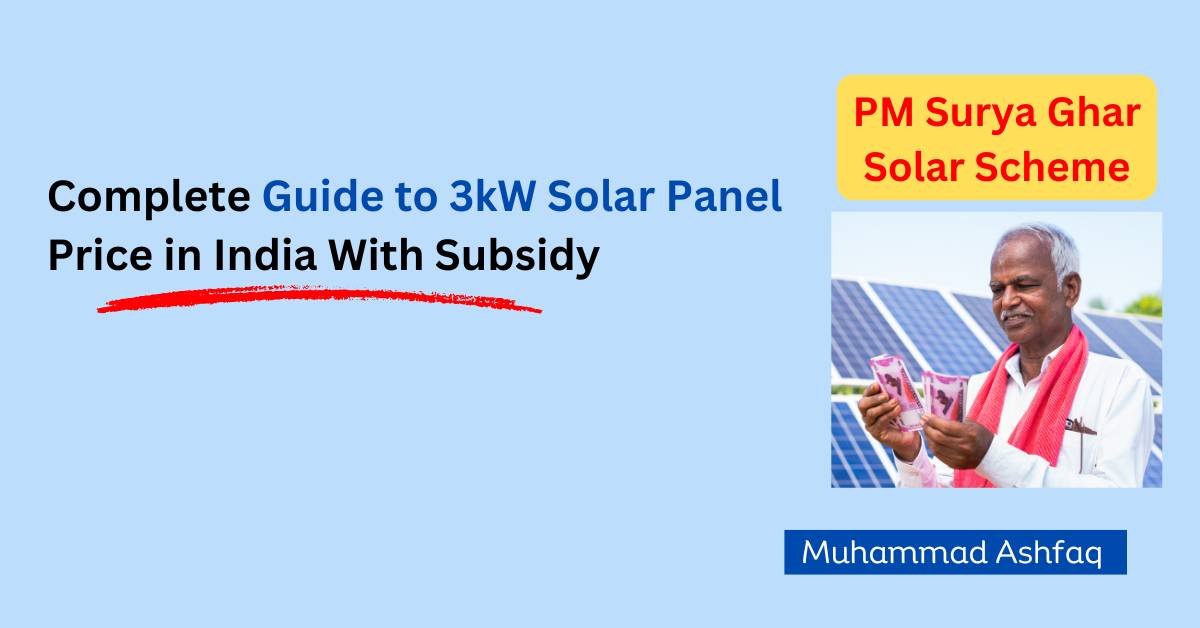Complete Guide to 3kW Solar Panel Pricing in India, Including Subsidy
Investing in a 3kW solar system is an effective step towards energy independence.
But before you make the leap, it’s crucial to understand the cost involved.
In India, the price of a 3kW solar system varies greatly depending on the type—whether it’s on-grid, off-grid, or hybrid.
And don’t forget about the savings from government subsidies, which can significantly lower your upfront costs.
Let’s break down the costs (with and without subsidies) and help you understand what you can power with a 3kw system.
I will also guide you through the eligibility criteria and the application process, providing you with all the necessary information to take advantage of the solar scheme.
Brief Overview of Solar Subsidy Scheme in India
The Indian government has implemented a solar subsidy scheme called the PM Surya Ghar Muft Bijli Yojana in 2024 to promote the adoption of rooftop solar systems in the residential sector.
Depending on the system size, this subsidy structure can cover up to 60% of homeowners’ installation costs.
The Ministry of New and Renewable Energy (MNRE) allocates funds for the Central Financial Assistance (CFA) under the Rooftop Solar Programme Phase II.
The CFA provides subsidies directly to residential consumers to reduce the upfront cost of installing rooftop solar systems.
3kW Solar System Price Without Subsidy
Depending on various factors, the price of a 3kW solar system in India without any subsidy ranges from approximately Rs. 1,60,000 to 3,50,000.
The exact amount is determined by the quality of components, brand, and installation complexity.
Here’s a breakdown of the average costs for a 3kW solar system in India.
| System Type | Price |
|---|---|
| 3kW On-grid solar system | Rs. 2,13,300 |
| 3kW Off-grid solar system | Rs. 2,40,000 |
| 3kW Hybrid solar system | Rs. 4,50,000 |
3kW Solar Panel System Price in India With Subsidy
Before knowing the prices of 3kw systems with a subsidy, it is important to understand how the subsidy is provided for different system sizes.
| Rooftop Solar System Capacity | Applicable Subsidy (₹) |
|---|---|
| 1 kW | 30,000/- |
| 2 kW | 60,000/ |
| 3 kW and Above | 78,000* |
Now onto the main point—what are prices after subsidy?
The subsidies are different for each type of solar system installation, like whether you have installed on grid off grid or hybrid.
Here’s a detailed overview:
3kW On-Grid Solar System:
- Price Before Subsidy: Approximately ₹2,13,300
- Subsidy Applicable: ₹78,000.
- Price After Subsidy: Approximately ₹1,35,300
3kW Off-Grid Solar System:
- Price: Approximately ₹2,40,000.
- Subsidy Applicable: Not applicable.
- Price After Subsidy: Remains ₹2,40,000.
3kW Hybrid Solar System:
- Price Before Subsidy: Approximately ₹4,50,000.
- Subsidy Applicable: ₹78,000.
- Price After Subsidy: Approximately ₹3,72,000.
Quick Overview: Types of 3kW Solar Systems Covered in Subsidy
In the context of solar energy, there are three primary types of systems: on-grid, off-grid, and hybrid. Each system has distinct characteristics, advantages, and applications.
On-Grid Solar System
An on-grid solar system, also known as a grid-tied system, is connected to the public electricity grid. This allows users to draw power from the grid when solar generation is insufficient and to feed excess electricity back into the grid.
Ideal for: Urban and suburban areas with reliable grid access where users want to reduce electricity bills without needing battery storage.
Off-Grid Solar System
An off-grid solar system operates independently of the utility grid. It generates and stores electricity for use without any reliance on external power sources.
Ideal For: Rural areas, remote locations, or places where grid access is unreliable.
Hybrid Solar System
A hybrid solar system combines features of both on-grid and off-grid systems. It can operate connected to the grid while also incorporating battery storage for added flexibility.
Ideal For: Users who want the benefits of both systems, particularly in areas with frequent power outages or where energy independence is desired.
Check out my detailed guide on Solar System Types to learn more about their differences and advantages.
How Many Units Can a 3kW Solar Panel System Generate?
Under optimal conditions, a 3kW solar system can generate 9 to 10 units (kWh) of electricity per day.
This estimate assumes around 6 to 7 hours of effective sunlight exposure, particularly during the summer months.
| System Size | Daily Output | Monthly Output | Yearly Output |
|---|---|---|---|
| 3 kW | 9 kWh | 270 kWh | 2590 kWh |
Remember! The actual output can vary based on several factors, including geographic location and how solar panels perform under different weather conditions.
What Appliances Can Be Run on a 3kW Solar System?
A 3kW solar panel system can power a variety of household appliances, including lighting loads and electronic devices.
Here’s a detailed list of the appliances that you can run on a 3kW solar system:

Note: The system cannot simultaneously support high-power appliances like air conditioners or water pumps.
As they exceed the instantaneous power capacity of a 3kW system.
How Much Can a 3kW Solar System Save on Your Electricity Bills?
The savings on electricity bills from a 3kW solar system are directly affected by electricity rates and energy consumption patterns.
The higher the electricity rates, the more you will save on your bill.
And consequently, the shorter will be the payback period of your solar investment.
A 3kW solar system typically generates between 250 to 300 kWh of electricity per month.
Depending on the local electricity rates, this can translate to monthly savings ranging from ₹1,500 to ₹5,000 (approximately $18 to $60).
Yearly savings can range from ₹18,000 to ₹60,000 (approximately $300 to $900)
While it may not cover the entire electricity bill, it definitely reduces energy costs and contributes to long-term savings.
You May Read: 2kW Solar Panel Price in India (Detailed Guide 2024)
Eligibility and Application Process for Solar Subsidy
To apply for a solar subsidy in India, particularly under the Rooftop Solar Programme Phase II, there are specific eligibility criteria and a structured application process.
Here’s a comprehensive overview:
Eligibility Criteria
- Residential Consumers: The subsidy is primarily available for residential solar installations.
- Installation by Approved Vendors: The solar system must be installed by vendors that are staffed by the government.
- Compliance with Guidelines: All installations must adhere to the Ministry of New and Renewable Energy (MNRE) guidelines.
Application Process
- Visit the National Portal: Go to the National Solar Rooftop Portal (https://pmsuryaghar.gov.in/) and register as a user.
- Fill Out the Application Form: Complete the online application form with accurate details about yourself and your solar project.
- Upload Required Documents: Submit necessary documents, including:
- Identity proof (e.g., Aadhaar card)
- Address proof
- Bank details
- Vendor quotation
- Verification by DISCOM: The local electricity distribution company (DISCOM) will verify your application and provide an in-principle approval and No Objection Certificate (NOC) for installation.
- Installation of the System: Once approved, the system can be installed by the chosen vendor.
- Inspection and Commissioning: After installation, DISCOM officials will inspect the system to ensure it meets all requirements.
- Subsidy Disbursement: Upon successful inspection and commissioning, the subsidy amount will be directly credited to your bank account within 30 days.
Does It Apply to Both New and Existing Installations?
The solar subsidy in India primarily applies to new installations only.
The subsidy does not typically apply to existing solar panel installations.
Unless they expand their system or add new components that qualify under the subsidy guidelines.
Is Solar Subsidy Available for Commercial Properties?
The subsidy is primarily aimed at residential installations.
Under the current scheme, commercial installations, including those for businesses and industries, are not eligible for the subsidy.
This means that businesses looking to install solar systems will need to bear the full cost without any financial assistance from the government.
Final Thoughts
That’s all about a 3kw solar panel system to get the most out of this scheme
With options like on-grid, off-grid, or hybrid systems, you can find the perfect fit for your home and lifestyle.
Plus, with subsidies available, going solar is more affordable than ever, helping you save money and see returns faster.
Lastly, it’s not just about cutting down your electricity bill; it’s about playing your part in building a carbon-free future.
FAQs
The price of a 3kW solar panel system in India ranges from ₹1,25,000 to ₹2,40,000, depending on whether it is an on-grid, off-grid, or hybrid system
For a 3kW off-grid solar system, you typically need 4 to 8 batteries (usually between 100Ah to 200Ah).
The price for a 3kW Tata solar system is generally around ₹1,35,000 to ₹2,10,000, depending on the specific configuration.
A 3kW solar panel system typically lasts between 20 to 25 years, although efficiency may gradually decrease over time due to wear and tear.
The price of a Luminous 3kW solar on-grid system is around ₹1,81,999, including solar panels and inverter.

Content Writer | Assistant Manager (Electrical) at IESCO
As a passionate content writer, I’m on a mission to make solar hassle-free for you through my expert guides and easy-to-digest content.

